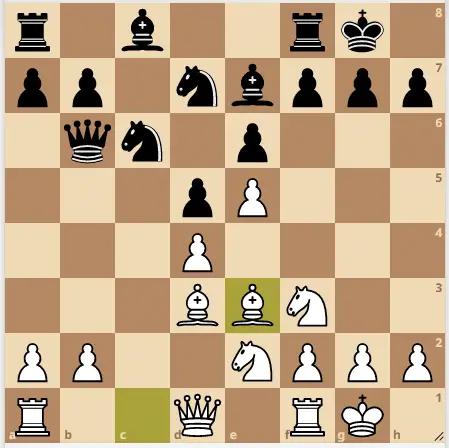One of the key phases of a chess game is the middlegame, which is the stage of the game where players have completed the development of their pieces and are looking to improve their position or create threats against their opponent.
In this article, we will explore in more detail what the middlegame is in chess, its importance in the game, some common middlegame strategies, and how it differs from the opening and endgame phases of the game.
Whether you are a beginner or an experienced chess player, understanding the middlegame is essential to improving your game and achieving success on the chessboard.
What Is The Middlegame In Chess?
The middlegame is the second phase of a chess game, which follows the opening and precedes the endgame. It typically starts around move 10-15 and continues until most of the pieces have been exchanged and the position has simplified into an endgame.
In the middlegame, both players have completed their development, and the position on the board is typically more open than in the opening.
During the middlegame, players aim to improve the position of their pieces, create threats, and prepare for the endgame.
It is a critical phase of the game where players have to carefully evaluate the position and formulate a plan based on the strengths and weaknesses of their position.
The middlegame requires tactical and strategic skills, as well as the ability to calculate variations and assess the position accurately. Players must be aware of potential threats and opportunities and decide how to allocate their resources to achieve their objectives.
Example of Middlegame

Middlegame Strategies
There are many middlegame strategies in chess, and the appropriate strategy depends on the specific position on the board. However, here are some common middlegame strategies:
Control the center
In the middlegame, controlling the center of the board is crucial. It allows the player to control more space and have more mobility for their pieces. Players often try to control the center with their pawns and pieces and use their control of the center to launch attacks or defend their position.
Reposition your pieces
In the opening, players develop their pieces to good squares, but in the middlegame, players may need to reposition their pieces to take advantage of weaknesses in their opponent’s position or to create new threats. Players should also try to coordinate their pieces to work together effectively.
Create pawn breaks
In positions where the pawn structure is locked, players may try to create pawn breaks to open up lines for their pieces or to create weaknesses in their opponent’s position. Pawn breaks can be risky, but they can also create opportunities for an attack.
Attack the opponent’s king
In positions where the opponent’s king is exposed or weakened, players may try to launch an attack against the king. This can involve sacrificing material to open up lines or using their pieces to create threats against the king.
Defend weaknesses
Players should always be on the lookout for weaknesses in their own position and defend them accordingly. This can involve placing pieces to guard weak pawns or squares or moving pieces to cover potential attack routes.
These are just a few examples of middlegame strategies. In reality, middlegame strategies can be very complex and depend on the specific position on the board.
Good middlegame play requires accurate assessment of the position and the ability to make the right decisions based on the strengths and weaknesses of the position.
Is The Middlegame The Most Important In Chess?
The middlegame is a critical phase of the game, and many games are won or lost during this stage. However, it’s not necessarily the most important phase of the game.
The opening is also important, as it sets the tone for the rest of the game and can dictate the type of position that will arise in the middlegame. A poor opening can put a player at a disadvantage, making it difficult to create a strong position in the middlegame.
The endgame is also critical since it’s the final phase of the game, and players must convert their advantage, or defend against their opponent’s threats to secure a win or a draw.
Overall, all three phases of the game are essential, and good chess players must have a strong grasp of all three to succeed. The opening, middlegame, and endgame are interconnected, and weaknesses in one phase can carry over to the next. Therefore, it’s crucial to have a balanced approach to the game and to study and practice all three phases to become a strong chess player.
What is the difference between middlegame and endgame?
The middlegame and endgame are two distinct phases of a chess game. The middlegame is the stage of the game where both players have completed the development of their pieces and are typically trying to improve their position or create threats against their opponent.
In contrast, the endgame is the final stage of the game, where most of the pieces have been exchanged, and the focus is on converting an advantage or defending against threats to secure a win or a draw.
Endgame: Fewer pieces left

In the middlegame, there are typically many pieces on the board, and the position is still complex and full of possibilities.
There is a lot of room for creativity and calculation as players look for ways to create or exploit imbalances in the position. The middlegame requires both strategic and tactical skills, as players must make decisions about where to place their pieces and how to coordinate them to create threats and defend against their opponent’s counterplay.
In contrast, the endgame is characterized by relatively few pieces on the board, and the position is often more simplified than in the middlegame.
The focus in the endgame is on precise calculation and technique as players try to convert their advantage or hold a draw.
Endgames require a deep understanding of pawn structures, the relative value of pieces, and the ability to calculate accurately to determine the best moves and avoid making mistakes that could cost the game.
Overall, the middlegame and endgame are two distinct phases of the game, each requiring different skills and strategies. While the middlegame is more open-ended and creative, the endgame is more precise and technical, and both are crucial to achieving success in chess.
Best Middlegame Chess Players
There have been many great chess players known for their exceptional middlegame skills. Here are a few examples:
Mikhail Tal
Tal was a Latvian grandmaster known for his aggressive and imaginative play. He was particularly skilled in the middlegame and known for his ability to launch devastating attacks against his opponents.
Garry Kasparov
Kasparov is a former world champion and considered one of the greatest chess players of all time. He was known for his aggressive and dynamic playstyle, particularly in the middlegame, where he could find creative solutions to seemingly impossible positions.
Anatoly Karpov
Karpov was also a former world champion and known for his solid and strategic playstyle. He was particularly skilled at positional play in the middlegame, often slowly and methodically outmaneuvering his opponents.
Viswanathan Anand
Anand is an Indian grandmaster known for his versatile and adaptable playstyle. He is particularly skilled at finding strong moves in complex middlegame positions and has a reputation for being one of the best rapid and blitz chess players.
Magnus Carlsen
Carlsen is a Norwegian grandmaster and the current world champion. He is known for his dynamic and aggressive playstyle in the middlegame, often taking calculated risks to create winning chances.
These are just a few examples of great middlegame chess players, but there have been many others throughout the history of the game.
Wrapping Up
In conclusion, the middlegame is a crucial stage of a chess game, where players must use their strategic and tactical skills to create or exploit imbalances in the position.
It is a complex and fascinating phase of the game that requires a deep understanding of pawn structures, piece coordination, and calculation.
By mastering some common middlegame strategies and developing a strong intuition for the position, chess players can gain a significant advantage over their opponents and increase their chances of success.
Related Post: Best chess middlegame strategy


